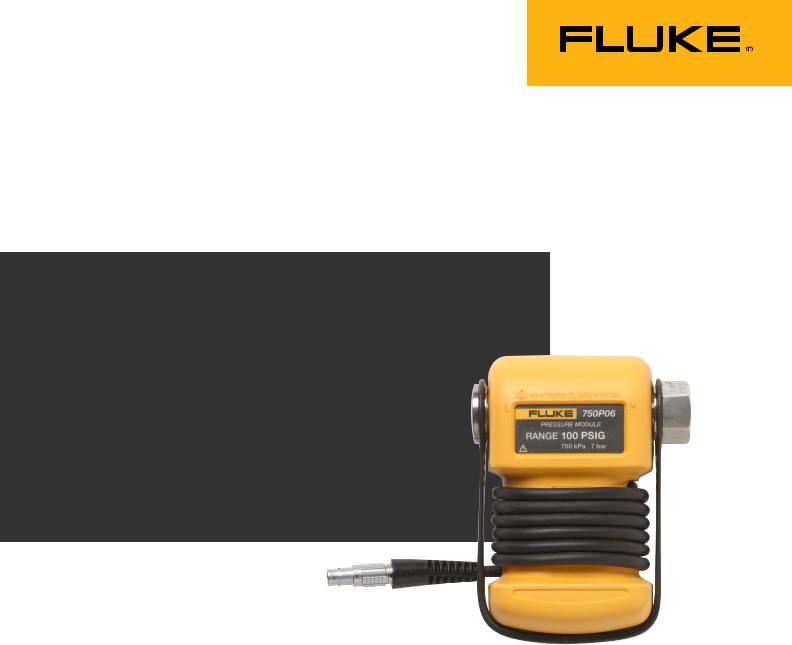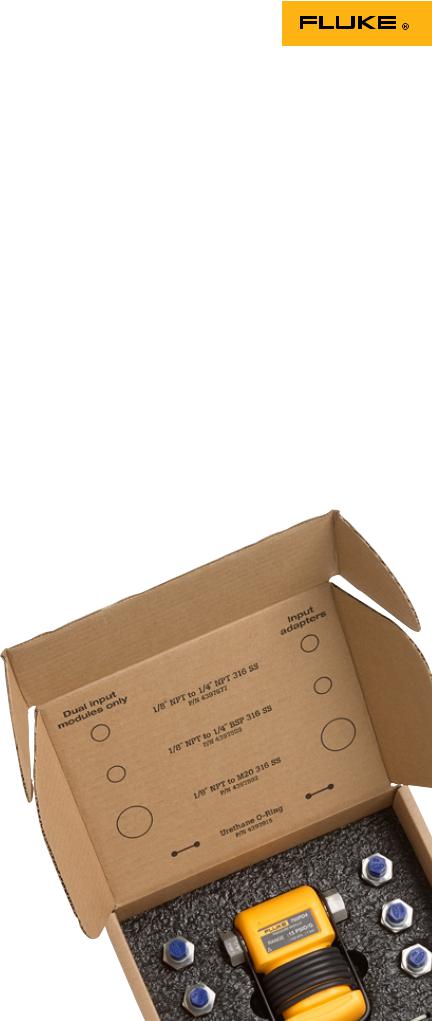Fluke 750PA8, 750PA9, 750PA6, 750PA7, 750PD27 Instruction Manual
...
Fluke 750P
Series Pressure
Modules
Precision pressure measurement for 75X and 720 series calibrators
The 750P Series Pressure Modules are the ideal pressure modules to enable gage, differential and absolute pressure measurement with Fluke 750 and 740 series DPCs and 725, 726 MPCs to measure pressure.
•0.025 % reference uncertainty
•6-month and 1-year specifications
•Temperature compensated 0 °C to 50
•Digital communication to calibrators, losses or errors
•Broad selection of ranges
•Gage, differential, dual range, absolute measurement models
A complete family of pressure modules
A family of 48 pressure modules covers pressure calibrations from 0 to 1 in H20 to 10000 psi (2.5 to 690 bar).
Gage pressure modules have one pressure fitting and measure the pressure with respect to atmospheric pressure. Differential pressure modules have two pressure fittings and measure the difference between the applied pressure on the high fitting versus the low fitting. Each module is clearly labeled for range, overpressure and media compatibility. All modules include NPT, metric (BSP) and M20 adapters.
Quick and easy measurements
Fluke 750P Series Pressure Modules are easy to use. To measure pressure, connect the pressure module to a pressure source or hand pump and then connect the pressure module cable to the calibrator. Apply pressure from the pressure source and it is displayed digitally on the calibrator. At the touch of a button, the pressure may be displayed in up to 11 different engineering units. When used with the 750 Series Documenting Process Calibrators, pressure readings can be date/time stamped and stored electronically for later retrieval. This saves time, eliminates errors, and supports compliance with quality standards and regulations.
Technical Data

Pressure module performance and technology
Fluke 750P Series pressure modules are highly accurate, with specifications that apply from 0 °C to 50 °C (32 °F to 122 °F), a feature that sets them apart from other pressure calibrators. Many ranges have total uncertainties of 0.04 % of full scale and reference uncertainties of 0.01 % of full scale (see specification table).
This performance is possible through the innovative application of mathematics and micro-processor power. Fluke pressure modules have silicon piezoresistor sensors which consist of a resistive bridge fabricated in a silicon diaphragm. Pressure applied to the diaphragm causes a change in the balance of the bridge which is proportional to the applied pressure. The bridge balance change is not linear and is very sensitive to temperature. However, since these effects are quite stable with time and with repetitive changes of condition, the sensors are carefully characterized.
During manufacture, Fluke pressure module sensors are characterized by reading temperature and pressure at multiple points. A least-squares regression is used to calculate the coefficients of a polynomial expression for pressure. The coefficients, unique to that pressure module, are stored in the module’s memory.
Each module has its own microprocessor, allowing it to run the measurement circuitry and to communicate digitally with a calibrator. When connected to the calibrator, the modules coefficients are uploaded from the pressure module to the calibrator. Then, as pressure measurements are made, raw sensor values for pressure and temperature are digitally loaded to the calibrator, where the raw sensor values and coefficients are manipulated to derive and display the pressure reading.
This innovative technique provides several benefits:
1.Digital communication eliminates errors due to poor connections and electrical interference.
2.The modules are inherently temperaturecompensated from 0 °C to 50 °C (32 °F to 122 °F).
3.The modules are fully interchangeable because all measurements are completed in the pressure module itself and then communicated to the calibrator in digitized form. Modules are calibrated independently of the calibrator, and can be used
with any 740, 750 or compatible 720 or 710 series calibrator. Each module has its own serial number to maintain independent traceability.
Sensor protection in isolated modules
Many of these modules (see table) incorporate a stainless steel diaphragm to isolate the sensor. With these modules, any medium that is compatible with stainless steel can be used on the high side of the module.
Rugged construction
A urethane overmolding protects against shock if a module is accidentally dropped and also seals against dirt, dust, and moisture. Pressure connections are
1/8” NPT female connection. A ¼” NPT Male, ¼” BSP/ ISO and M20 male adapter are also provided with each pressure module.
Convenient setup
A one-meter cable between the pressure module and calibrator reduces the length of connecting tubing to the pressure source. The remote pressure head also provides an extra margin of safety and convenience by removing the calibrator and operator from the pressure source in the event or need for semi-remote measurements.
2 Fluke Corporation Fluke 750P Series Pressure Modules
